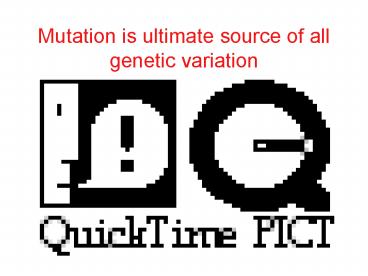Mutation is ultimate source of all genetic variation PowerPoint PPT Presentation
1 / 30
Title: Mutation is ultimate source of all genetic variation
1
Mutation is ultimate source of all genetic
variation
2
Other ways populations generate or acquire
genetic variation?
- Gene flow (migration)
- Recombination
- Hybridization
- Horizontal gene transfer
3
Mutations in animals
- Germ line mutations
- Somatic mutations
- Which are heritable?
4
Mutations single base-pair mutations
Purines Pyrimidines
Transitions Transversions
Synonymous substitution
Non-synonymous subst. (silent)
(replacement) TGT --gt TGC TGT --gt
TGG Cys --gt Cys Cys --gt Trp
5
Other silent mutations
- single-base mutations, deletions, or insertions
within introns - mutations within other non-coding regions such as
repetitive DNA and pseudogenes
6
However, some noncoding sequences have essential
functions
- promoters
- enhancers
- transcription termination signals
- intron splice junctions
- Mutations in these noncoding regions will have
phenotypic effects.
7
Mutation rates
8
Best data from C. elegans
- Accumulated mutations in 72 inbred lines for 400
generations - Sequenced 62,000 bp from each line
- 30 mutations
- 13 insertions (1-500 bp)
- 4 deletions (1-66 bp)
- 13 base substitutions (8 transitions
5 transversions) - 2.1 mutations per haploid genome per generation
- Denver et al. (2004) Nature 430 679-683.
9
Effects of mutations
Proportion of new mutations
0 (neutral)
lethal or sterile
deleterious
beneficial
10
Transposable elements
- translocate from one location to another
- can cause deletions, insertions, inversions,
rearrangements
11
Hybrid Dysgenesis
- Sterility and gonad abnormalities in offspring of
some crosses between different populations of
Drosophila melanogaster. - But only in one direction of the cross!
- Mv x P
- Pv x M
- Pv x P
- Mv x M
- dysgenesis normal
12
Hybrid dysgenesis is due to TEs called P
elements
- Flies that can produce dysgenesis have these P
elements, but dysgenesis only occurs when males
that have these elements are crossed to females
that dont have them. Eggs from P females
suppresses transposition. - P elements spread through natural populations
starting abut 50 years ago. - Suppressor of transposition also evolved in these
pops.
- But many old laboratory populations dont have
P elements b/c they were established from natural
populations more than 50 years ago.
13
Hybrid Dysgenesis
- Also observed in other organisms
- Mammals (marsupials)
- Plants (rice)
- Probably occurs in other organisms too.
14
Are mutations random?
- With respect to selective advantage?
- That is, do mutations arise spontaneously without
regard to whether or not they are advantageous in
the current environment? Or, is there a tendency
for mutations to occur that are advantageous in
the current environment?
15
Lederberg Lederberg (1952)
- Asked whether adaptation arose from a process of
random mutation followed by selection in a new
environment, or whether environmental stressors
directly induce mutations that confer an
adaptive. - Knew that if a population of E. coli was exposed
to antibiotic, most of the bacterial cells would
die. But, if the original population was large
enough, it would soon be repopulated with
bacteria, all of which were resistant to the
antibiotic. - Does antiobiotic select for rare pre-existing
cells that have the resistance mutation, or does
the antibiotic itself induce the cells to produce
new mutations that confer resistance?
16
Sterile velvet stamp
Master Plate--bacterial colonies on a petri dish
Replica plates on selective media (streptomycin)
Replica plates on non- selective media (no
antibiotic)
17
Conclusions
- Mutations arise randomly with respect to
selective advantage in the current environment.
18
Are mutations random?
- With respect to position in the genome?
- No, mutational hotspots exist
- Positions in DNA that mutate more frequently than
expected (more often than other positions) - Due to unusual character of those sites
- (e.g. repeated sequences, methylated bases)
19
Chromosomal mutations are the source of variation
for chromosomal evolution
20
Gene duplications are a source of evolutionary
novelty
- Ribosomal DNA
- Globins (alpha and beta)
- Homeobox genes
21
Inversions
22
(No Transcript)
23
Inversions Suppress Recombination!
- Organisms carrying an inversion tend to undergo
little crossing over in the inversion region in
both inversion and non-inversion chromosomes.
24
(No Transcript)
25
(No Transcript)
26
(No Transcript)
27
(No Transcript)
28
Hybridization introgression
M. musculus
Hybrid zone
M. domesticus
29
Horizontal gene transfer
- Species that cannot interbreed should not be able
to exchange genes - But, a few cases of transfer of genetic material
between distantly related species - Cross-infection by retroviruses (which can
incorporate host DNA into their genomes) is
suspected route of gene transfer.
30
Virogenes are vertebrate genes that are similar
to, and thought to have arisen from, retroviruses

